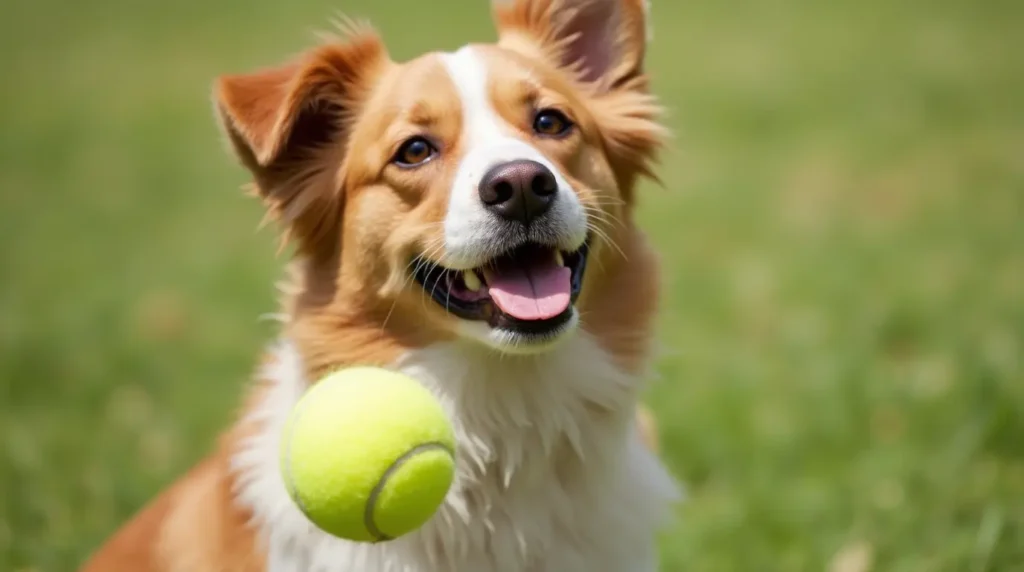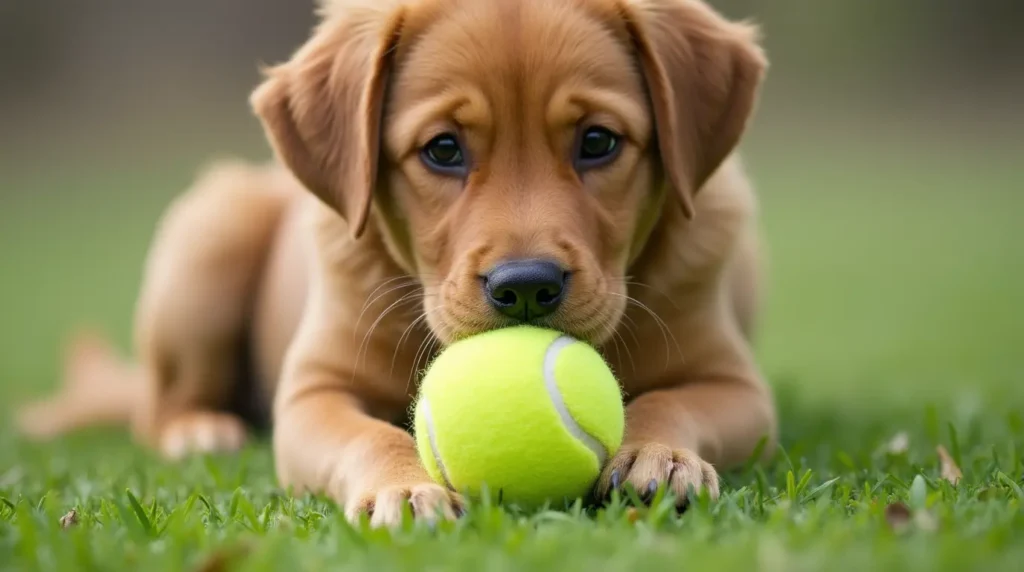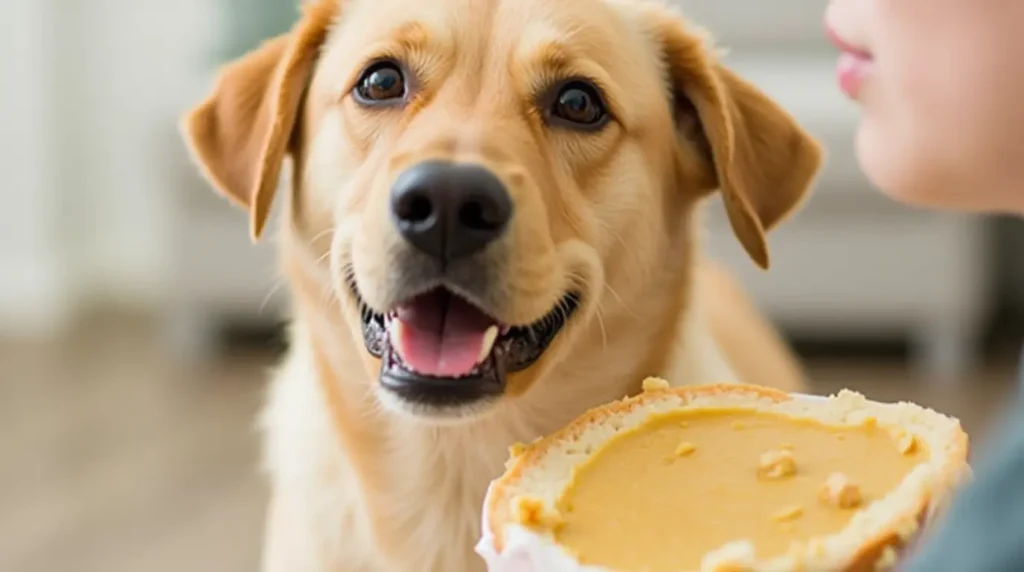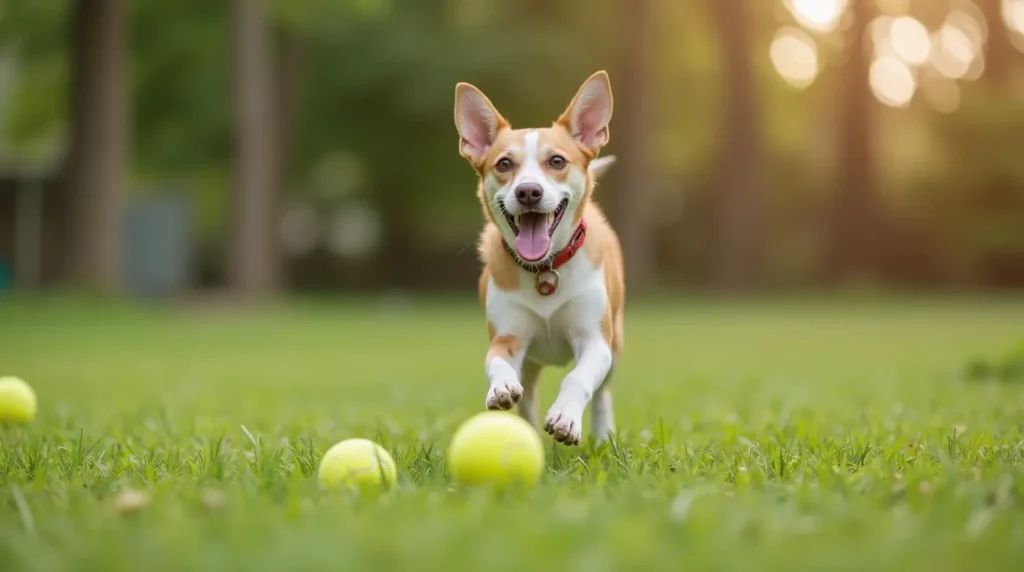There’s something almost magical about the relationship between dogs and tennis balls. The moment you pull out that fuzzy, bright yellow sphere, your four-legged friend’s eyes light up with pure joy. Their tail wags frantically, and they’re suddenly consumed with an intense focus that borders on obsession. But have you ever wondered why do dogs love tennis balls so much? What is it about these simple objects that drives our canine companions wild with excitement?
This peculiar love affair between dogs and tennis balls isn’t just a coincidence—it’s deeply rooted in canine psychology, evolutionary history, and sensory experiences. From the perfect size and unpredictable bounce to the satisfying texture and distinctive smell, tennis balls seem custom-designed to appeal to everything dogs love most.
In this comprehensive guide, we’ll dive into the fascinating science behind your dog’s tennis ball obsession. We’ll explore the evolutionary reasons, the sensory appeal, and even address some safety concerns about this beloved canine toy. By understanding what makes tennis balls so irresistible to our furry friends, we can better appreciate this unique bond and ensure our dogs enjoy their favorite toy safely.
Why Do Dogs Love Tennis Balls? 🎾❤️

Dogs and tennis balls share one of the most iconic relationships in the pet world. But what exactly makes these fuzzy spheres so incredibly appealing to our canine companions?
The answer lies in a perfect storm of factors that align perfectly with your dog’s natural instincts and sensory preferences:
Prey Drive Satisfaction
Tennis balls tap directly into your dog’s predatory instincts. The size, motion, and feel of a tennis ball mimic the characteristics of small prey animals that dogs’ wild ancestors would have hunted. When a tennis ball rolls unpredictably across the ground or bounces erratically through the air, it triggers your dog’s chase instinct—the same instinct that would have helped their wolf ancestors catch dinner.
Dr. Stanley Coren, renowned canine psychologist and author of “How Dogs Think,” explains: “The movement of the ball stimulates the dog’s predatory sequence—the natural chain of behaviors involved in hunting prey. This includes searching, stalking, chasing, catching, and possessing.”
Perfect Size and Texture
Tennis balls seem almost purposely designed for the canine mouth. For most medium to large breeds, a standard tennis ball fits perfectly between their jaws—large enough to be easily spotted and chased, but small enough to be comfortably carried. The fuzzy texture also provides just the right amount of resistance when chewed, creating a satisfying sensory experience.
Visual Appeal
Dogs may not see the world in the same vibrant colors we do, but the bright yellow-green of a tennis ball stands out dramatically against most backgrounds, even to a dog’s dichromatic vision (which primarily perceives yellows, blues, and grays). This high contrast makes tennis balls incredibly easy for dogs to track, even when moving at high speeds.
Unpredictable Movement
Unlike many other toys, tennis balls bounce and roll in ways that are difficult to predict. This unpredictability mimics the erratic movements of prey animals and keeps your dog engaged and mentally stimulated. Each bounce presents a new challenge, turning a simple game of fetch into an exciting and dynamic experience.
Scent Factor
While we might only notice the rubber smell of a new tennis ball, your dog’s superior sense of smell detects much more. Tennis balls absorb and hold scents wonderfully, making each ball uniquely aromatic to your dog. The more your dog plays with their tennis ball, the more it becomes infused with their scent, creating a powerful sense of ownership and attachment.
Positive Association
Perhaps most importantly, tennis balls often become associated with play, outdoor adventures, and quality time with their favorite human. This positive reinforcement creates a powerful emotional connection between your dog and their beloved tennis ball.
Why Do Dogs Love Playing Tug of War? 💪🐕

While tennis balls may be the ultimate canine obsession for many dogs, tug of war ranks high on the list of favorite doggy activities. This primal game taps into different but equally powerful canine instincts:
Social Bonding Through Controlled Competition
Tug of war provides a structured way for dogs to engage in friendly competition with their humans or other dogs. In the wild, canines often engage in similar behaviors to establish hierarchy without resorting to actual fighting. When played with proper rules and boundaries, tug games can actually strengthen the bond between you and your dog.
Outlet for Natural Strength
Dogs are naturally powerful animals, and tug of war gives them an appropriate outlet to exercise their strength. The resistance of the toy against their pull provides satisfying feedback that many dogs find highly rewarding.
Mental Stimulation
A good game of tug involves strategy, timing, and focus—all of which provide valuable mental exercise for your dog. They must coordinate their movements, adjust their grip, and respond to your actions, creating a mentally engaging experience.
Physical Exercise
Tug of war engages multiple muscle groups and provides excellent physical exercise in a relatively small space. For high-energy dogs or during bad weather when outdoor activities are limited, a vigorous tug session can help burn excess energy.
Interestingly, many dogs who love tennis balls also enjoy combining their passions by playing tug with specialty tennis ball tug toys, getting the best of both worlds!
Why Do Dogs Love Humans? ❤️👫
The bond between dogs and humans represents one of the oldest and most successful interspecies relationships in history. This deep connection helps explain why activities like playing fetch with tennis balls become so meaningful:
Co-Evolutionary Partnership
Unlike most other animals, dogs have evolved specifically to live and work alongside humans for at least 15,000 years. This shared evolutionary history has created a unique interspecies understanding where dogs have developed specialized skills for reading human emotions, gestures, and intentions.
Research from Dr. Brian Hare’s Duke Canine Cognition Center shows that dogs can understand human pointing gestures from a very young age—a skill even chimpanzees struggle with despite their genetic similarity to humans. This innate ability to understand human communication forms the foundation of the human-dog bond.
Oxytocin Connection
When you and your dog gaze into each other’s eyes during a play session with a tennis ball, both of you experience a surge of oxytocin—often called the “love hormone.” A groundbreaking study published in Science showed that positive interactions between dogs and their owners trigger the same oxytocin release patterns seen between mothers and infants.
Social Creatures By Nature
Dogs are inherently social animals descended from wolves, who live in cooperative family groups. This natural sociability has been enhanced through domestication, with modern dogs showing a particular affinity for human companionship—often preferring it even to the company of other dogs.
Mutual Benefits
The relationship between dogs and humans has always been built on mutual advantage. Historically, humans provided food, shelter, and protection, while dogs offered assistance with hunting, protection, and companionship. Today, this relationship continues with dogs providing emotional support, companionship, and joy while humans provide care and enrichment—often in the form of tennis ball games!
Why Do Dogs Like Squeaky Balls? 🔊🎾

Many dogs show an intense fascination with squeaky toys, including squeaky tennis balls. This attraction has deep evolutionary roots:
Prey Drive Trigger
The high-pitched squeak of these toys closely resembles the sounds made by small prey animals in distress. To your dog’s ears, that squeak sounds remarkably similar to the sound a small rodent might make when caught—triggering an instinctive response that’s both exciting and rewarding.
Instant Feedback
Dogs learn through immediate feedback, and squeaky toys provide instant auditory confirmation of a successful bite or squeeze. This immediate reward system makes squeaky toys particularly engaging and satisfying.
Arousal and Excitement
The sound of a squeaky toy can raise a dog’s excitement level and increase their engagement with the toy. For many dogs, the squeak creates a stimulating play experience that keeps them interested longer than silent toys.
Sensory Enrichment
The combination of sound, texture, and movement provides multi-sensory enrichment that many dogs find deeply satisfying. Squeaky tennis balls engage multiple senses simultaneously, creating a richer play experience.
Some experts believe that dogs who “de-squeak” their toys (intentionally removing or destroying the squeaker) might be acting on their predatory instinct to “kill” the prey once caught. This doesn’t indicate aggression—just natural canine behavior!
Why Do Dogs Love Belly Rubs? 🤗🐾
The belly rub represents one of the most vulnerable and trusting interactions between dogs and humans. Understanding this beloved canine pleasure helps contextualize their other preferences:
Vulnerability as Trust
When a dog rolls over and exposes their belly, they’re showing extreme trust. The stomach area contains vital organs and represents one of the most vulnerable parts of a dog’s body. By allowing you to touch this area, your dog is demonstrating profound trust in your relationship.
Pleasurable Sensation
The skin on a dog’s belly contains numerous nerve endings that create pleasurable sensations when gently stroked. Unlike some other areas with thicker fur or skin, the belly is particularly sensitive to touch.
Temperature Regulation
The belly area has thinner fur and is close to many blood vessels. A gentle belly rub can help dogs cool down, which can feel particularly good after vigorous activities—like chasing tennis balls!
Positive Reinforcement
Belly rubs are almost always paired with positive attention, verbal praise, and quality time—creating a powerful positive association through classical conditioning. Over time, dogs learn to associate belly rubs with feelings of safety, comfort, and pleasure.
The connection between belly rubs and tennis ball play often forms a perfect play routine: vigorous fetch sessions followed by relaxing belly rubs create a balanced activity cycle that satisfies both active and calming needs for your dog.
Why Do Dogs Love Peanut Butter? 🥜😋

Peanut butter presents another fascinating canine preference that, like tennis balls, seems uniquely designed to appeal to our furry friends:
Flavor Intensity
Dogs have about one-sixth the number of taste buds that humans have, which leads them to prefer strongly flavored foods. Peanut butter’s rich, intense flavor profile registers strongly even on a dog’s less sensitive palate.
Fat Content Attraction
In nature, high-fat foods provide concentrated energy—something wild canines would naturally seek out. Peanut butter’s significant fat content triggers ancestral preferences for calorie-dense foods.
Texture Appeal
The sticky, thick texture of peanut butter provides an interesting sensory experience that many dogs find engaging. The unique mouth-feel creates a long-lasting taste experience as they work to lick every bit from the roof of their mouth.
Scent Factor
Dogs experience much of their “taste” through smell, and peanut butter has a powerful aroma that appeals to their sensitive noses. The strong nutty scent can be detected from a distance, creating anticipation and excitement.
Some clever dog owners have discovered that combining two canine favorites—spreading a tiny bit of peanut butter on a tennis ball—can create the ultimate high-value training reward for teaching fetch and recall commands!
Why Do Dogs Love Bones? 🦴🐕
The classic image of a dog with a bone represents another innate canine preference with evolutionary origins:
Dental Health
Chewing on appropriate bones helps clean dogs’ teeth naturally. The mechanical action of gnawing scrapes away plaque and stimulates gums, while the rough texture acts as a natural dental cleaner.
Mental Stimulation
Working to extract marrow and tasty bits from bones provides excellent cognitive exercise. This problem-solving activity engages your dog’s brain and helps prevent boredom.
Ancestral Connection
Wild canids have always consumed bones as part of their natural diet. The act of chewing bones connects to deeply ingrained behavioral patterns that have existed throughout canine evolutionary history.
Stress Relief
The repetitive action of chewing releases endorphins in a dog’s brain, creating a calming effect similar to what humans might experience through activities like meditation or deep breathing exercises. After an exciting tennis ball chase session, many dogs enjoy settling down with a good chew item.
Nutritional Benefits
Bones contain minerals like calcium and phosphorus, along with nutrients in the marrow. While modern dog foods meet all nutritional requirements, the instinct to seek these nutrients through bone chewing remains strong.
It’s worth noting that while tennis balls and bones both appeal to different aspects of canine instinct, bones present potential safety hazards that tennis balls generally don’t. Always supervise bone-chewing and choose appropriate options for your dog’s size and chewing style.
Are Tennis Balls Bad For Dogs? ⚠️🎾

Despite their popularity, tennis balls do come with some potential concerns that responsible pet owners should consider:
Dental Wear
The fuzzy covering on tennis balls is abrasive—think of it as sandpaper for dog teeth. Dogs who habitually chew tennis balls can experience significant dental wear over time, potentially wearing down their teeth prematurely. This is especially concerning for “tennis ball addicts” who constantly chew their favorite toy.
Dr. Thomas Chamberlain, a veterinary dental specialist, warns: “The fuzz on tennis balls contains an abrasive material that will wear down your dog’s teeth over time in the same way that sandpaper will smooth wood. This can lead to exposure of the sensitive pulp cavity and painful dental conditions.”
Choking Hazard
Tennis balls can pose a choking risk, particularly for large breed dogs with strong jaws. Dogs can compress tennis balls, and if the compressed ball lodges in the back of the throat, it can block the airway. This risk increases if the ball becomes damaged or breaks into pieces.
Chemical Concerns
Standard tennis balls are manufactured for human sports, not as dog toys. They may contain chemicals or dyes that aren’t intended for animal consumption. Dedicated dog-specific tennis balls use pet-safe materials and dyes, making them a safer alternative.
Digestive Issues
Dogs who destroy and ingest pieces of tennis balls may experience digestive blockages requiring veterinary intervention or even surgery. The felt covering and rubber components can cause serious intestinal problems if swallowed in sufficient quantities.
Safer Alternatives
For dogs who love tennis balls but may be at risk from these concerns, consider these safer alternatives:
- Dog-specific rubber balls (like Chuck-It! balls)
- Balls with smoother surfaces that minimize dental wear
- Balls sized appropriately for your dog’s breed
- Supervised play only with balls of any type
Many veterinarians recommend removing tennis balls after play sessions rather than allowing them as constant chew toys. This approach maintains the fun while minimizing risks.
FAQ: Everything You Wanted to Know About Dogs and Tennis Balls
Why is my dog obsessed with tennis balls?
Your dog’s obsession with tennis balls stems from a perfect combination of factors that appeal to their natural instincts. The size, texture, unpredictable movement, and bright color all stimulate your dog’s prey drive—the same instinct that would drive wolves to hunt small animals. Tennis balls also provide mental stimulation through problem-solving (where will it bounce next?) and physical satisfaction through chasing and catching. Additionally, the positive associations with playtime, your attention, and the dopamine release from successful catches reinforce this obsession. Some dogs develop stronger attachments than others due to breed tendencies (retrievers are particularly prone to ball obsession) or individual personality traits.
Is it OK for my dog to chew on tennis balls?
Occasional chewing during play sessions is generally acceptable, but tennis balls shouldn’t be used as dedicated chew toys. The abrasive felt covering can wear down teeth over time, potentially causing dental problems. Additionally, tennis balls can break apart when chewed aggressively, creating choking hazards or digestive blockages if swallowed. If your dog enjoys chewing, provide appropriate chew toys specifically designed for this purpose, and reserve tennis balls primarily for interactive play like fetch. For heavy chewers, consider rubber alternatives specifically designed for dogs, which provide similar enjoyment with fewer risks.
Why do dogs love the smell of tennis balls?
Dogs have approximately 300 million olfactory receptors compared to our mere 6 million, making their sense of smell incredibly powerful. Tennis balls have a distinctive rubber smell that dogs find interesting, but the real olfactory appeal develops over time. As your dog plays with a tennis ball, it absorbs their saliva and scent, essentially becoming “marked” as their possession. Tennis balls also readily pick up environmental odors from grass, dirt, and other surroundings, creating a rich sensory tapestry that tells a story your dog can read through scent. This increasingly complex smell profile makes used tennis balls even more appealing than new ones to many dogs.
Can dogs see tennis balls?
Yes, dogs can definitely see tennis balls, though they perceive them differently than humans do. Dogs have dichromatic vision (essentially blue-yellow color perception) rather than trichromatic vision like humans. The bright yellow-green color of tennis balls appears as a vibrant yellow to dogs, creating high contrast against most backgrounds like grass or flooring. This high contrast makes tennis balls particularly visible and easy to track. Additionally, dogs have superior motion detection abilities compared to humans, allowing them to track the fast, erratic movements of a bouncing tennis ball with remarkable precision. This combination of high contrast color and excellent motion tracking makes tennis balls visually appealing and easy for dogs to follow during play.
Conclusion: The Timeless Appeal of the Tennis Ball
The love affair between dogs and tennis balls represents a perfect harmony of evolutionary instincts, sensory appeal, and positive associations. From the thrill of the chase to the satisfaction of the catch, tennis balls engage multiple canine instincts simultaneously, creating an almost irresistible appeal for many dogs.
Understanding why dogs love tennis balls helps us appreciate this seemingly simple toy as something much more profound—a key that unlocks your dog’s natural instincts in a safe, domesticated context. When your dog chases a tennis ball, they’re connecting with their ancestral past while simultaneously strengthening their bond with you.
For safe enjoyment of this classic canine favorite:
- Choose dog-specific tennis balls when possible
- Supervise play sessions, especially with aggressive chewers
- Store tennis balls away between play sessions rather than allowing constant access
- Replace damaged or dirty balls regularly
- Consider sizing appropriate to your dog’s breed
With these precautions in mind, that simple game of fetch becomes more than just play—it becomes a celebration of the unique bond between humans and dogs that has evolved over thousands of years. The next time your dog’s eyes light up at the sight of a tennis ball, you’ll understand that you’re witnessing something truly special: the perfect intersection of instinct, evolution, and joy.
So grab a tennis ball, head outside, and create some tail-wagging memories with your four-legged friend. After all, few things in life are as simple yet as deeply satisfying as watching your dog experience the pure joy of chasing their favorite yellow orb across the grass.
